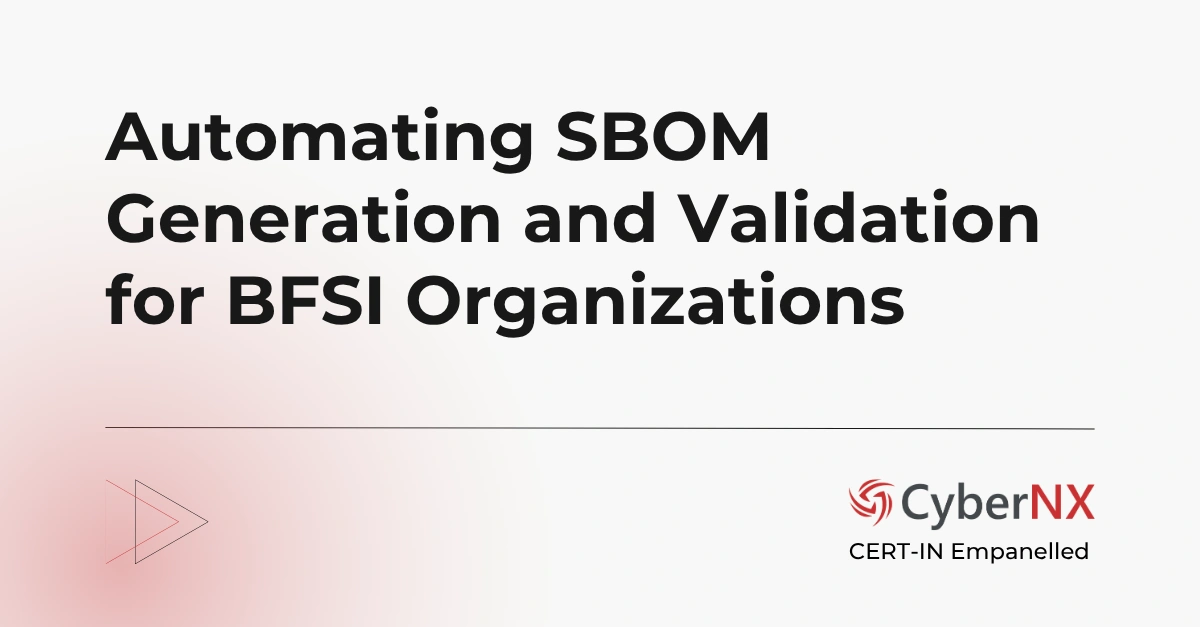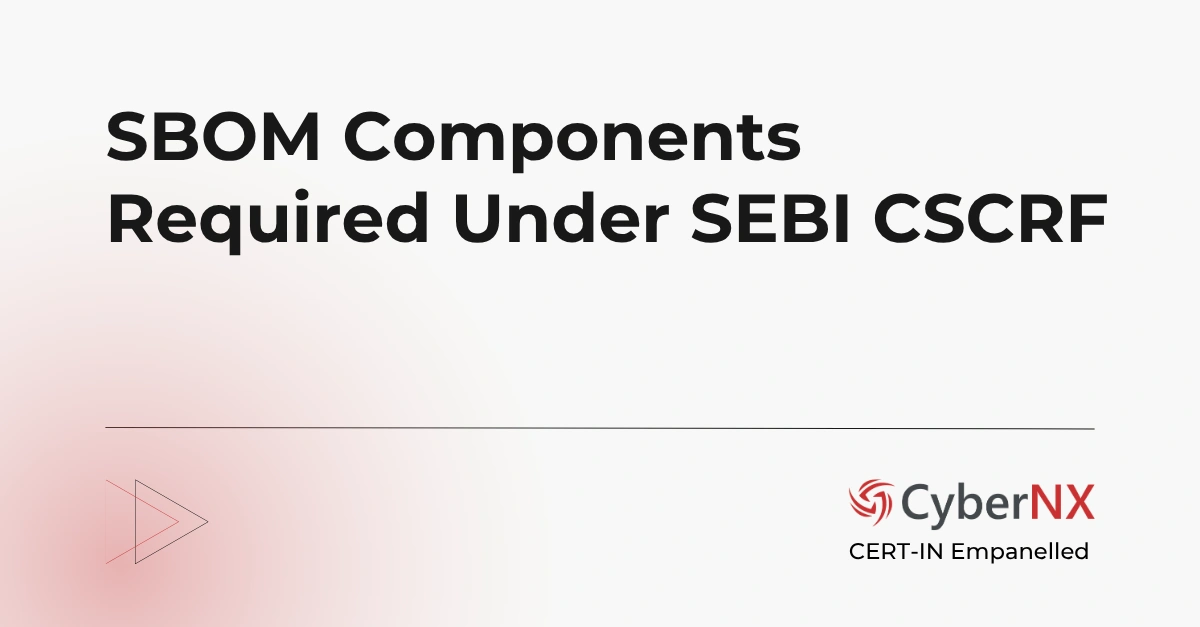Software Bill of Materials (SBOM) Report provides a structured view of all software components, dependencies and risks. Without it, organisations lack visibility into what they actually operate. But many SBOM reports fall short of audit-ready standards.
In this blog, we unpack the essential contents of an SBOM report that every audit team must include. This blog aims to speak directly to CISOs, IT Heads and security leaders who want clarity, not fluff.
Why the SBOM Report matters in an audit
Before diving into contents, let’s briefly recognise why a well-crafted SBOM report is so important.
- It creates transparency over your software supply chain and component usage.
- It helps identify known vulnerabilities and licensing or compliance risks.
- It supports procurement, vendor-risk management and regulatory compliance (for example in sectors like finance and critical infrastructure).
- It equips auditors and stakeholders with a consistent view of what was assessed, what was found and how to remediate.
In short: when we work alongside your team, delivering an audit-ready SBOM report is a foundational step for strong supply-chain risk management.
Essential sections of the SBOM Report
Here is a breakdown of the key sections that every SBOM report should include, in the order typically seen in audit work.
1. Cover page and metadata
Your report should open with a clear cover page that includes:
- Report title and version
- Date of generation
- Scope of the software systems and modules covered
- Name of audit team/organisation
- Authorisation or sign-off line
This front section sets expectations. For instance, one recent sector checklist highlights “Cover Page & Metadata” as the first component. It helps anyone reading the report understand upfront what was covered.
2. Executive summary
This is a concise overview for decision-makers. It should summarise:
- What the SBOM covers (which applications, modules, versions).
- High-level findings (e.g. number of components, number of vulnerabilities, critical risks).
- Key recommendations or next steps.
We recommend writing the executive summary in plain language. For example: “We found 245 components of which 17 are end-of-life, and we recommend patching or replacing these within 90 days.” This gives leadership a quick glance before diving into detail.
3. Component inventory and dependency map
This is one of the most important technical sections and often the bulk of the report. It should contain:
- A list of all software components (open source, third party, proprietary) that are in scope.
- For each component: name, version, supplier/vendor, licence (if applicable).
- The dependency relationships: for example, which components are directly used, which are transitively included.\Metadata fields such as timestamp of generation, methodology used, author of SBOM.
From our experience, this section is where many organisations need help – tracking transitive dependencies is often overlooked yet major risk.
4. Vulnerability and licensing status
Once you have component inventory, the next step is to link it to risk and compliance. This section should include:
- For each component, any known vulnerabilities (CVE IDs, severity ratings) and patch status.
- Licence information and any potential conflicts (especially with open‐source components).
- Status of remediation: e.g. open, in-progress, closed and due dates for fixes. (Some regulatory checklists mandate this.)
By doing this, your SBOM Report becomes not just an inventory but a risk dashboard.
5. Lifecycle, change log & provenance
It is insufficient to capture a one-time snapshot. Auditors expect visibility into how software evolves. This section should cover:
- Software lifecycle phase (build, release, deployment) at which the SBOM was generated.
- Change log: what changed since previous version – new components added, removed, updated versions.
- Provenance data: who supplied the component, how it was acquired, whether the SBOM generation process is automated or manual.
We emphasise to clients: organisations that track change logs have far quicker incident response if a vulnerability is disclosed.
6. Risk assessment and remediation plan
Now that you have inventory and status, you need assessment and action. In this section:
- Provide a risk matrix: categorise components (e.g. high/medium/low risk) based on version age, known vulnerabilities, supplier stability etc.
- Prioritise remediation: which components require immediate attention, which can be scheduled.
- Outline remediation plan: patching, replacement, upgrade or removal, plus responsible parties and timelines.
- Provide recommendations for governance improvements (e.g. automated SBOM generation, continuous monitoring).
From our audit experience, this is the section that translates insights into impact. It bridges the technical findings and board-level actions.
7. Compliance and regulatory alignment (India focus)
In India, the regulatory environment around CERT-In-style SBOM report is evolving fast. Audits should ensure your SBOM aligns with local rules and sectoral mandates.
Key items to include:
- A clear statement of which Indian regulations or frameworks apply. For example, the CERT-In “Technical Guidelines on SBOM” dated July 2025.
- How your SBOM aligns with those guidelines: what you already meet, and where gaps still exist (for instance machine-readable format requirement, inclusion of all transitive dependencies, or regular update cycles).
- Sector-specific obligations: for example, the Securities and Exchange Board of India (SEBI) Cyber Security and Cyber Resilience Framework (CSCRF) for regulated financial entities now expects SBOM-type transparency in software assets.
- How procurement/vendor workflows reflect SBOM expectations (e.g. contracts requiring SBOM from software vendors, legacy system exemptions with documented risk).
- A declaration that the SBOM has been prepared in accordance with the guidelines, plus attestation by responsible stakeholders (audit team, software owner) where required for regulated entities.
In our practice we emphasise framing SBOM content in terms of Indian regulatory expectations helps executive-leaders and risk-committees see its strategic value.
8. Appendices and supporting data
Finally, the report should include appendices or supplementary material:
- Raw inventory tables (perhaps in machine-readable format)
- Definitions and glossary of terms
- Methodology of SBOM generation (tooling used, version, date)
- Evidence and logs collected during audit
- Change history of the SBOM itself
Including these supports traceability and future audits.
Practical tips for preparing the SBOM Report
From our years of experience in cybersecurity audits, we suggest these best practices for SBOM report:
- Automate as much as possible: manual spreadsheets are error-prone and slow.
- Update continuously: treat the SBOM as a living document, not a one-off deliverable.
- Prioritise high-risk components: focus your remediation plan where it matters.
- Make the report accessible to non-technical stakeholders: the executive summary and risk assessment are key.
- Keep tooling and formats consistent: use standards like SPDX or CycloneDX so downstream users and auditors can consume the SBOM easily.
- Document gaps clearly: if some components cannot yet be identified or dependencies are opaque, note this in the report rather than pretend completeness.
Conclusion
An SBOM report is far more than a list of components. When done right it becomes a strategic tool: part audit deliverable, part risk dashboard, part governance artefact. We’ve shown you the essential contents every cybersecurity audit should include. From metadata and component inventory through to risk assessment, remediation plan and regulatory alignment.
At CyberNX, we work alongside your team to craft SBOM Reports that deliver clarity, action and assurance. If you’d like to explore how our SBOM tool can help your next audit or SBOM generation, let’s talk. Every step you take with us will strengthen your software supply chain visibility and resilience.
SBOM report FAQs
How often should an SBOM Report be produced?
The frequency depends on change rate in your software, but at minimum it should be aligned with major releases, patches or quarterly reviews. Continuous update is ideal.
Does an SBOM Report cover only open-source components?
No. It should cover all components – open-source, third-party, proprietary – that are included in the software artefact you audit. This ensures full supply-chain transparency.
What format should the SBOM inventory be in?
It should include both a human-readable report and preferably a machine-readable file using standards like SPDX or CycloneDX. This supports automation and integration.
What are the common pitfalls when preparing an SBOM Report?
Here are the common pitfalls noticed:
- Missing transitive dependencies (i.e. components used by components).
- Out-of-date component versions and missing vulnerability data.
- Lack of clear remediation plan or ownership.
- Poor alignment with regulatory expectations or audit readiness.






